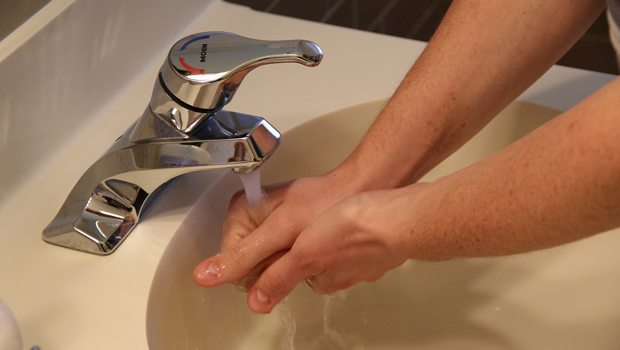8 ways to stay healthy this cold and flu season
The Health and Wellness Center wants everyone to know that it takes more than hand washing to prevent infections. As we head into the season when colds and flu reach epidemic proportions, it’s time to review what we can do to help fight the germs that cause these illnesses—and others, such as stomach bugs—and stay healthy this winter. The main reason colds, flu, and other infections spread like wildfire through your office and your school is because people don’t take the basic precautions experts recommend.
Catching someone else’s germs is as easy as getting them on your hands, then touching your eyes, nose, or mouth–which we do an average of 15.7 times an hour, according to a study at University of California, Berkeley. That’s why frequent hand washing is the top expert-recommended infection-prevention strategy. But that’s not the only thing you need to do. Here is a quick rundown of other strategies everyone should adopt to stay healthy this winter and how to keep your germs to yourself if you do get sick:
1. Use the right soap
You can skip the anti-bacterial stuff with ingredients such as triclosan, which was recently banned by the Food and Drug Administration. The agency declared that there’s no evidence that anti-bacterial soap eradicates bacteria any better than regular soap, and it may contribute to the rise in antibiotic-resistant superbugs as well as disruptions in hormonal regulation. The Centers for Disease Control and Prevention (CDC) recommends scrubbing with basic soap and water for a full 20 seconds to reduce the number of bacteria or viruses you may have picked up on your hands.
2. Avoid the handshake
It’s becoming more common—and less socially awkward—to skip hand-to-hand contact (and the subsequent germ exchange) during cold and flu season. “Fist bumps and elbow bumps are replacing the handshake in many settings,” says William Schaffner, MD, professor of preventive medicine and infectious disease at Vanderbilt University Medical Center in Nashville, TN. “Among my infectious disease colleagues I see a version of the South Asian ‘Namaste,’ where we put our hands together at our chests, make eye contact, and give a little bow.”
3. Cover your coughs and sneezes properly
If you’re the one who’s spewing germs, one way to keep them to yourself is to sneeze or cough into the crook of your elbow. “When you cough or sneeze, that air comes out with a good degree of force, spreading virus particles to anyone within a 3- to 6-foot range,” says Lisa Grohskopf, MD, a medical officer in the Influenza Division at the CDC. Sneezing or coughing into your hand will help keep the germs from going airborne, but if you don’t wash your hands immediately, you’ll spread the germs the minute you touch anything or anyone.
4. Keep your distance
Respiratory viruses, like colds and flu, can spread easily through the air. “When someone who’s sick exhales, they breathe out microscopic droplets of fluid containing the virus,” Schaffner says. “And anyone else within their ‘breathing zone’ can then breathe in that infected air.” To stay safely out of reach, keep about 6 feet between you and any sick person who is likely to breathe, cough, or sneeze in your direction.
5. Know that germs can linger
Another reason to wash your hands frequently is that surfaces stay germy for longer than you might think. A study from the University of Buffalo found that stuffed toys, books, and cribs at a day care tested positive for bacteria that cause ear infections and strep throat even after the facility had been closed overnight. And according to the CDC, flu viruses can live on hard surfaces (such as doorknobs or phones) for 2 to 8 hours. An article published in the American Journal of Infection Control noted that the bug that causes norovirus—an extremely contagious viral infection that produces diarrhea and vomiting—can survive up to seven days on a hard, dry surface, and the bacteria that cause MRSA have been found to survive months. Even cold germs can live anywhere from 2 hours to seven days on hard surfaces, and about 2 hours on skin.
6. Clean often-touched surfaces
Because those nasty bacteria and viruses stick around on surfaces for hours or even days, cleaning is key. “I recommend an approach called ‘targeted hygiene,’” says Elizabeth Scott, PhD, co-director of the Simmons Center for Hygiene and Health in Home and Community at Simmons College in Boston, and co-author of a 2012 study. “This means targeting cleaning and disinfection practices when and where there is a risk of infection transmission.” For example, if someone has a respiratory infection or gastrointestinal infection in a given setting, such as at home or the office, that would be the time to target those common touch surfaces on a regular, at least daily, basis. At the office, wipe down shared work spaces and equipment, such as copy machines that the whole office touches. At home, focus on the hard surfaces—like doorknobs, faucets, and TV remotes—on which bacteria live the longest. Just as with hand washing, you can skip the anti-bacterial cleaning products. Experts say any household cleaner—or a diluted bleach solution—will do the trick.
7. Get vaccinated
Although it’s no guarantee you won’t get the flu, getting a flu vaccine every fall is still your best defense. Experts can’t predict the effectiveness of this year’s vaccine, but Grohskopf says that last year, getting the shot resulted in a 50 percent reduced risk of coming down with the flu. “And if you do get sick, you may have milder symptoms,” she says. It takes two weeks after the shot for your immune system to build up the necessary, protective antibodies, so getting it in the fall—before flu activity ramps up—is ideal.
8. Know when to stay home
“At the height of your symptoms, you need to stay home for one or two days in order to not get other people sick,” says Aaron E. Glatt, MD, chairman of the department of medicine at South Nassau Communities Hospital in Oceanside, NY. And while you’re home recovering, take precautions to help keep the rest of the household healthy. Don’t take charge of the family’s food prep while you’re sick, and try to hole up in one room as much as possible in order to keep your germs to yourself.
For more information, contact Teresa Dadez, director of Health Services, at (352) 588-8347 or teresa.dadez@saintleo.edu. You can also stop by the Health and Wellness Center in DeChantal Hall, room 125.






